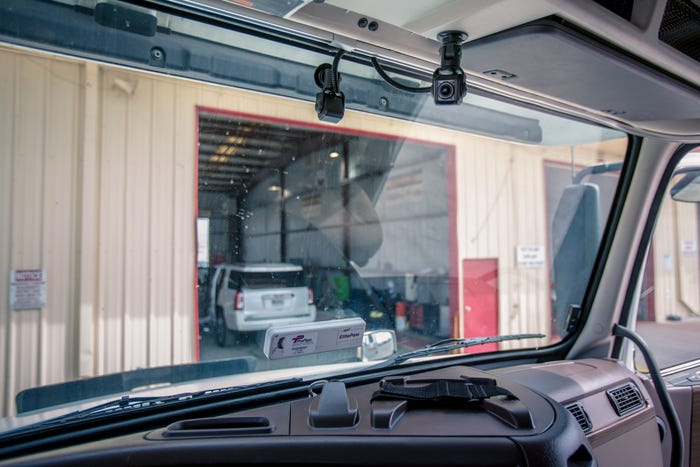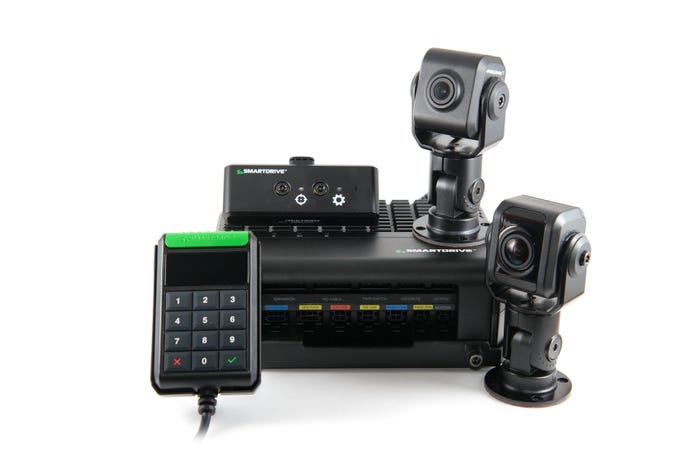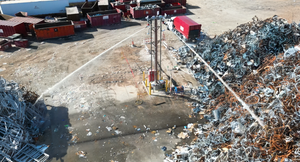SmartDrive Works to Reduce Incidents and Injuries with Video-based Safety, Analytics
The company is transforming fleet safety and operational efficiency with top-notch driving performance solutions and transportation intelligence.
It’s no secret that the job of a refuse and recyclable material collector is ranked in the top 10 on the most dangerous jobs in America list. And it’s to no surprise that those involved in the industry are working hard to remove that job from the list by developing and implementing safer products, policies and procedures.
One of the companies striving to improve safety and reduce the number of incidents and injuries that occur in the industry is SmartDrive Systems Inc., a San Diego-based company that delivers driving performance solutions and transportation intelligence that transform fleet safety and operational efficiency.
“SmartDrive has been in business since 2004, and we primarily focus on safety as a service, which is part of what makes us different,” says Jason Palmer, COO of SmartDrive. “We pioneer the category of video-based safety as a managed service, installing a series of sensors in a vehicle to analyze how the vehicle and driver are performing. Once something is identified as a performance need, video is triggered and data is collected and sent to one of our 500-plus driving analysts who review the video for more than 90 observations and create a driver performance portfolio that can be accessed by fleet managers to see what problems they have with their fleet and what problems particular drivers have.”
SmartDrive’s solutions can be compared to a DVR, according to Palmer, but instead of sitting and watching the recorded videos to identify performance needs, driving analysts and fleet managers have immediate access to the videos that feature performance needs detected by sensors, saving both time and money, improving safety programs, reducing claims processes and increasing safety measures.
The driver performance portfolios, which are put together by SmartDrive’s driving analysts, include information on each individual driver, including a driving safety score. Like golf, the lower the score, the better. If a driver receives a high score due to a safety incident, for example, he or she can work with a training coach to improve and lower the score. The portfolios also allow managers to identify the top and common risks and adjust their training programs as necessary to focus on those problem areas.
Last year, the company launched new capabilities that extend the value of SmartDrive 360, the company’s solution that enables fleets to deploy additional cameras to gain 360-degree insight into risk, and SmartSense, a new line of intelligent driver-asset sensors designed to identify dangerous driving risk, intervene with drivers and provide actionable coaching before an incident or injury occurs.
SmartDrive 360’s on-demand video capability now features triggering on up to four cameras simultaneously based upon high-risk maneuvers, making it easy for customers to access and view the complete picture of high-risk events, such as a swerve or U-turn, in a timely manner. This capability goes hand-in-hand with the SmartDrive Promise: “We deliver video in minutes, not days.”
Combining purpose-built sensors with engine computer data, telematics, accelerometer data and SmartDrive analytic data, the SmartSense sensors deliver new levels of analyzed risky driving events. One of the sensors, SmartSense for Distracted Driving, pairs the advanced computer vision-based algorithms with the SmartDrive video and analytics platform to address the epidemic of distracted and inattentive driving. Instead of relying only on vehicle maneuvers, such as hard breaking, lane departure or swerving, the sensor interprets driver cues, such as head and eye movements, to detect distraction, inattention or drowsiness.
“Distracted driving and fatigue are both major issues within the industry, and our SmartDrive line helps measure drivers’ ability to operate a vehicle and monitor and detect fatigue,” says Palmer. “SmartSense for Distracted Driving, for example, creates a heatmap of a driver’s face, detecting when a driver takes his eyes off the road, closes his eyes for a certain period of time, pulls out his cell phone to text or take a call, etc. This sensor, along with the others in the SmartDrive line, allows managers to get in front of dangerous situations by receiving alerts and being able to talk to their drivers before an incident or injury happens.”
When it comes to reducing injuries and incidents and improving safety, Palmer suggests that companies look at their own operation and business practices to help identify if they are putting drivers in a situation where they are going to be distracted.
“Companies often think of cell phones when they think of distracted driving, but it’s much more than that,” says Palmer. “Some companies are still using print paperwork for routes and directions, which can be a safety risk because the drivers may pull out the paperwork and look at it while driving instead of pulling over every time they need to confirm a stop on their route or their next direction move. Companies need to ensure they aren’t offering additional safety risks by installing GPS or having a digital route, for example, and drivers need to make sure they aren’t accepting any additional safety risks.”
In addition to launching new solutions, the company had a number of accomplishments in 2017. It reported a 30 percent year-over-year subscription growth, a 96 percent increase in straight-to-rollout deployments and a 98 percent retention of contracted units over the prior year. It also tripled its transportation intelligence business over the prior year, added leading global fleets across a variety of industry categories and closed equity investment in the company led by Michelin North America.
As far as the company’s impact on customers goes, the SmartDrive program traversed 3.7 billion miles, issued 2.5 million alerts to SmartDrive team members and customers, helped avoid 24,000 collisions and captured 23,612 collisions.
“While 2017 was the year of the ELD, fleets and insurance companies are stating that 2018 will be the year of video—something we’ve already seen evidenced by our own significant growth,” said Steve Mitgang, CEO of SmartDrive, in a statement. “Fleets are beginning to understand that it takes more than video to drive results. Our goal with transportation and video intelligence is to help drivers and fleets make better decisions faster and to eliminate the need for unfocused and partially correct data. Our platform stands apart in its ability to provide actionable information to fleets that can make a true difference in their business, instead of making the data overload problem worse.”
Adding to its video-based solutions offerings, SmartDrive announced the release of its SmartDrive Transportation Intelligence Platform and SR4 hardware last week, which deliver breakthrough driving performance insights and analytic intelligence by combining data from all systems, all sensors and the operating environment.

The platform includes advanced risk assessment and driver-assist, more power in a small hardware footprint, more multi-camera support for 360-degree visibility, integration of WABCO’s next-generation OnLane LANE Departure Warning System as the road-facing camera, more storage capacity for Extended Recording service, expanded integration options to third-party systems, mixed fleet capability, enhanced reliability and security and an industry-leading SmartChoice Video Safety Program.
“Building on our track record of innovation and commitment to system openness, the introduction of this groundbreaking, new platform provides fleets a solution capable of true convergence and serves as a foundation on which to build as new and enhanced technologies are adopted in the next three to five years,” said Mitgang in a statement. “At the same time, it delivers superior capabilities and impressive enhancements to our video-safety program that set the standard for what fleets should expect from their solution investment.”
The SR4 hardware offers a purpose-built controller unit featuring intelligent monitoring and recording functions, expandable solid-state storage and 4G/LTE and Bluetooth 4.x communication protocols, significantly smaller road and cab-facing cameras, a separate sensor bar that allows more flexibility in camera placement, a keypad that enables manual event recording while supporting unique identification codes and a privacy mode for drivers and a wireless key fob that puts the power of manual recording in the hands of the driver, whether the driver is inside or outside the vehicle.

“The transportation industry has seen a trend of devices getting larger as they add more advanced capabilities, whereas tech innovation demands that hardware become smaller and sleeker while delivering more power and functionality,” said Mitgang in a statement. “The SR4 meets these expectations by delivering unprecedented compute power, seamless integration with third-party systems and the most advanced risk assessment capabilities—all within a discreet footprint.”
One of the challenges that the company faces when developing these technologies is waste vehicles being noisy and sometimes bumpy to ride in, which can cause unnecessary triggers. To overcome this challenge, SmartDrive works to develop sophisticated algorithms to avoid quick, unnecessary triggers.
“We have more than 200 million driving profiles, and we have analysts working with those profiles every day to help us see what’s creating a false positive so we can tune our algorithms as necessary,” says Palmer.
Going into 2018 and beyond, the company is continuing to work on creating those fine-tuned algorithms and new and improved video-based safety solutions and analytics.
“One of the things that we are working on is convergence of many devices and data,” says Palmer. “For a long time, it was all about video stream and DVR, but over the last couple of years, we have seen and developed a lot more computer-vision systems capable of doing real-time analysis, which provides more opportunities for us to improve safety and efficiency. Moving forward, we will continue to work with customers to find new ways to leverage computer vision to do things other than detect fatigue and distracted or inattentive driving.”
About the Author
You May Also Like




.png?width=300&auto=webp&quality=80&disable=upscale)